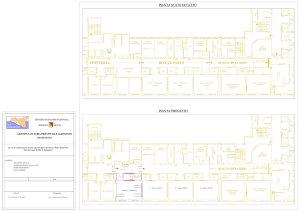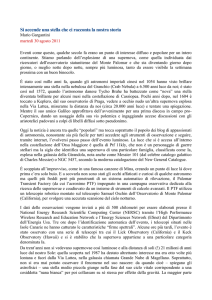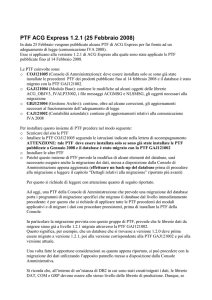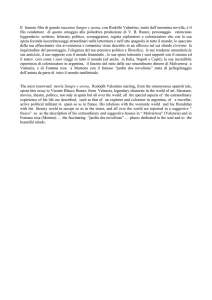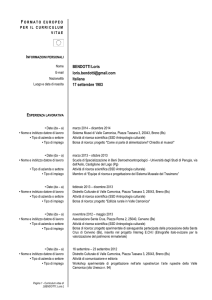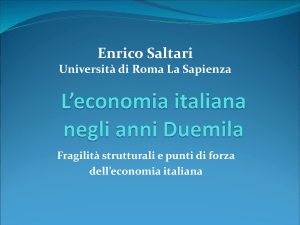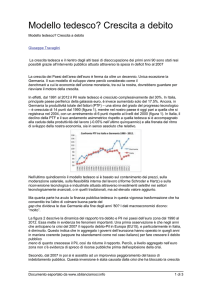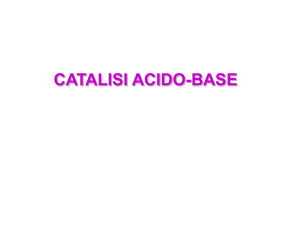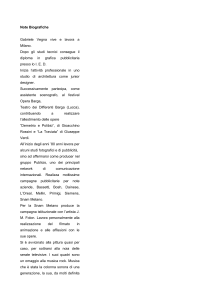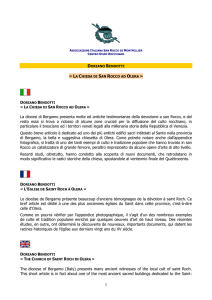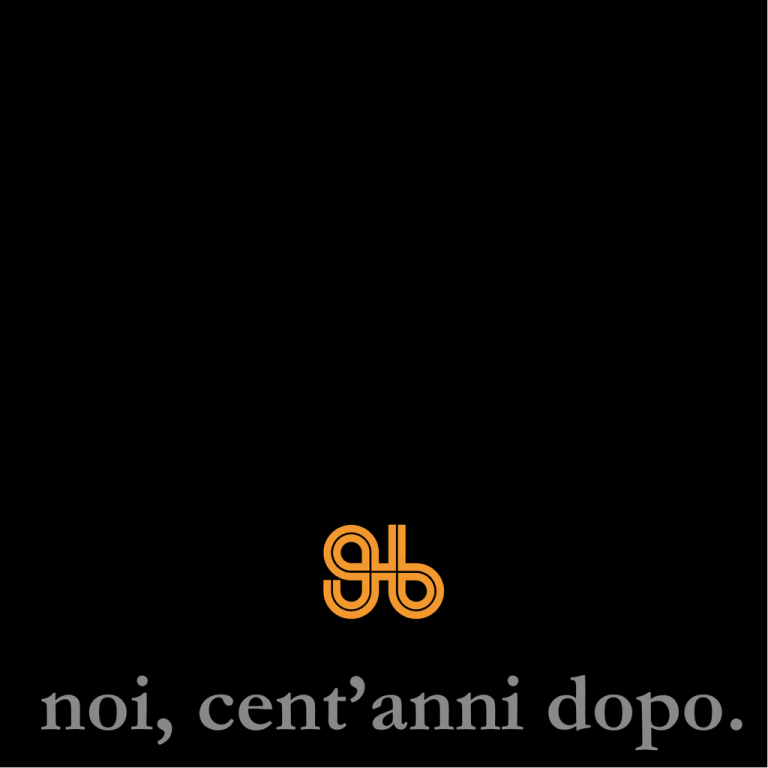
noi, cent’anni dopo.
us, after a hundred years.
1
parole
Cent’anni per un’industria, sono pochi e tanti insieme. Pochi, perché
non significano di certo il raggiungimento della vecchiaia tipica
dell’uomo. Tutt’altro: sono il segnale di una leadership consolidata,
quasi certificata dal tempo trascorso, dalle sfide imprenditoriali che
in un secolo sono per forza innumerevoli, dell’affermarsi, forno dopo
forno, del nome Bendotti. E sono tanti perché nel passaggio delle
generazioni (in Bendotti sono quattro) si costituisce un patrimonio
aziendale continuamente arricchito dagli incontri con persone e
luoghi di tutto il mondo, e con la tradizione e l’innovazione delle più
diverse culture produttive. A tutto ciò va aggiunto l’intrecciarsi e il
migliorarsi delle esperienze progettuali interne, costrette a misurarsi
con i problemi costruttivi di ciascun forno costruito su misura per
ogni cliente. Ecco perché il centenario Bendotti è una piattaforma
produttiva di livello difficilmente eguagliabile. E dalla quale non è
possibile tornare indietro: è dal 1916 che riscaldiamo il futuro.
One hundred years for an industrial activity are few and many at the
same time. They are few, because certainly they do not reach an old
age, which is typical of men. Not at all: they are the expression of a
consolidated leadership, almost certified by the passing of time, by the
entrepreneurial challenges that, of course, were many during a century,
and asserting the Bendotti name, furnace after furnace. In addition,
they are many because generation after generation (four in Bendotti),
a corporate heritage is created and it is continuously enriched by the
meetings with people and places all over the world, as well as with the
tradition and the innovation of the most diverse manufacturing cultures.
It adds to interlacing and improving in-house design experiences,
which had to face the structural problems of each furnace, which is
manufactured to measure for every customer. This is the reason why
the Bendotti centenary is a matchless manufacturing platform. And we
cannot go back: since 1916 we have been reheating the future.
Il nostro compito
è domare il fuoco.
Our duty is taming fire.
2
persone
È dal 1916 che il nome Bendotti è legato ai forni industriali. Evaristo,
il capostipite, ha firmato il primo progetto di un forno. Giulio, il
figlio, l’avvio del grande sviluppo dell’azienda negli anni cinquanta
del 900. È di Evaristo e di Martino, figli di Giulio, lo slancio verso
i mercati mondiali e, proprio grazie alle necessità create da questo
internazionalizzarsi, l’ideazione del metodo Bendotti, che ha nella
prefabbricazione, il suo cuore più innovativo. Tocca quindi alla
quarta generazione, a Giulio e Margherita, figli di Evaristo, e a
Michele, figlio di Martino, misurarsi con la competizione globale,
cui rispondono, come da tradizione famigliare, con il massimo
impegno nella ricerca di soluzioni al passo di questi nostri tempi, così
impegnativi e nello stesso tempo avvincenti. La garanzia del successo
sta in questo: la Forni Industriali Bendotti è saldamente in mano alla
dinastia Bendotti, ed i clienti, tutti, hanno come interlocutore ultimo
e decisivo qualcuno che porta il nome Bendotti.
The Bendotti name has been associated with industrial furnaces
since 1916. Evaristo, the progenitor, signed the first furnace project.
Giulio, his son, started the huge development of the company
during the 1950s. Evaristo and Martino, Giulio’s sons, ventured
into international markets and, thanks to the needs created by the
above-mentioned internationalisation, conceived the Bendotti
method, where prefabrication represents its greatest innovation.
Therefore, it was the fourth generation, Giulio and Margherita,
Evaristo’s children, and Michele, Martino’s son, who had to face
global competition. As a family tradition, they are reacting with
maximum commitment in looking for forefront solutions, in
a period that is so demanding and, at the same time, engaging.
Success is assured as follows: Forni Industriali Bendotti is firmly
run by the Bendotti dynasty, and all customers can rely on a crucial
contact person with the Bendotti name.
3
logo
Abbiamo la pazienza
e la dedizione necessarie
per ottimizzare ogni
We have the necessary patience and expertise to streamline every
“Il primo incontro con i Signori Evaristo e Martino
Bendotti, chiamato a seguire e coordinare l’immagine
grafica dell’azienda, risale al 1978. L’esigenza dell’azienda
era di trasmettere solidità, qualità, serietà e l’intenzione era
di avere un marchio di forma geometrica ben definita, con
una base lineare. Il marchio, esistente, era quello stampato
sulle carte da lettera, non c’era un disegno esecutivo; l’ho
ridisegnato mantenendone le caratteristiche grafiche,
creando una modulazione armonica, per verificarne il
possibile utilizzo. Secondo me il marchio, graficamente
valido, doveva essere mantenuto nella sua forma originale.
Per assecondare le linee guida avute dalla Bendotti l’ho
inserito all’interno di un quadrato, arrotondandone gli angoli
per avere un’armonia stilistica con le curve del disegno.”
progetto.
project.
“First meeting with Evaristo and Martino Bendotti, who
invited me to manage and coordinate the graphic image of
the company, dates back to 1978. The need was to convey
soundness, quality, reliability, and wished to have a brand
with a well-defined geometrical shape and a linear base. The
existing brand was printed on writing paper with no executive
drawing. I redrew it maintaining the same graphical features,
creating a harmonious modulation to verify if its use was
possible. In my opinion, the original shape of the brand had
to be maintained, as it was valid from the graphical point
of view. To meet the guidelines given by Bendotti, I put the
brand into a square, making its corners round in order to
obtain stylistic harmony with the curves of the drawing”.
Giordano Redaelli
4
artisti
Giordano Redaelli, Franca Ghitti, Graziano Gregori,
Mauro Staccioli, P. Lion, Maurizio Galimberti, Vincent
Bousserez. Bendotti ha cercato di ispirarsi ai valori
espressi da questi artisti davvero unici. Alla pazienza
della packaging art di Redaelli per costruire un significato
nuovo ad icone risapute; all’umiltà con cui la Ghitti
plasmava materiali carichi di storia, distillandone miti
primordiali. Al rigore scenografico di Gregori utile
a domare la forza selvaggia del fuoco; alle geometrie
smisurate di Staccioli necessarie a traguardare l’infinito.
Alla dedizione di P. Lion per musicare al meglio la vita. Alla
passione di Galimberti verso il millimetrico spostamento
nella ripetizione modulare di immagini; alla sensibilità di
Bousserez rivolta ai suoi piccoli eroi che, meglio di noi,
sanno parlare intorno alla grandezza dell’uomo.
Giordano Redaelli, Franca Ghitti, Graziano Gregori,
Mauro Staccioli, P. Lion, Maurizio Galimberti, Vincent
Bousserez. Bendotti tried to draw its inspiration from
the values that are expressed by the above-mentioned
unique artists. Patience of packaging art by Redaelli to
create a new meaning for well-known icons; modesty
used by Ghitti to mould materials that are full of history
to extract primeval myths. The stage-designing rigour by
Gregori, which is useful to control the wild force of fire;
the huge geometries of Staccioli, which are necessary to
sight infinity. P. Lion’s devotion to better set life to music.
Galimberti’s passion to the millimetric displacement in
the modular repetition of images; Bousserez’s sensitivity
to its tiny heroes, who are better than us in talking about
human greatness.
Giordano Redaelli
Giordano Redaelli vive in Brianza ed alterna la propria
attività tra Milano e l’hinterland. La formazione
professionale è avvenuta a Milano presso la Scuola
Grafica Salesiana e la Scuola Superiore d’Arte del
Castello con la specializzazione in grafica pubblicitaria
e arti visive. Contemporaneamente approfondisce le
materie artistiche e architettoniche frequentando la
facoltà di Architettura del Politecnico di Milano. Assolve
un master all’Istituto Europeo di Design. Partecipa a
diversi incontri con autorevoli personaggi della grafica
internazionale quali: Pino Tovaglia, Armando Milani,
Bruno Munari.
Inizia l’attività professionale come impaginatore grafico,
poi come art-director della rivista settimanale “Sorrisi
e Canzoni TV”. Come libero professionista fonda lo
studio grafico “Giordano Redaelli” a Milano lavorando
nei diversi campi della comunicazione. Dopo tre anni di
consulenza come art director per un’agenzia specializzata
nel settore del mobile apre uno studio anche a Giussano,
la società Methodus, che opera esclusivamente nel campo
dell’arredamento. Nel settore editoriale ha collaborato
con importanti case editrici: Arnoldo Mondadori
Editore, Casa Editrice Universo, Edizioni San Paolo, Il
Sole 24Ore. Nell’ambito pubblicitario ha collaborato con
aziende di livello internazionale.
L’esperienza acquisita nel settore grafico e nel packaging,
l’attitudine all’arte pittorica e il grande interesse verso
gli artisti della Pop Art, gettano le fondamenta per
un’esplorazione nell’arte contemporanea.
Giordano Redaelli lives in Brianza, Italy, and its activity
is alternated between Milan and the hinterland. His
professional training took place in Milan at the Scuola
Grafica Salesiana and the Scuola Superiore d’Arte del
Castello, with a specialization in advertising design
and visual arts. At the same time, he studied artistic
and architectural subjects by attending the Faculty of
Architecture at the Politecnico di Milano. He obtained a
master degree at the IED, “Istituto Europeo di Design.” He
attended various meetings with influential international
designers, such as Pino Tovaglia, Armando Milani, and
Bruno Munari.
He started his professional activity as graphic-layout
man, and then became art-director of the Italian weekly
magazine “Sorrisi e Canzoni TV.” As a freelance, he
founded the design firm “Giordano Redaelli” in Milan,
dealing with various communication fields. After three
years as consulting art director for a specialised agency
of the furniture industry, he opened another firm in
Giussano: the company Methodus, which is dedicated
to the furnishing industry. As far as the publishing
sector is concerned, he collaborated with important
publishing houses: Arnoldo Mondadori Editore, Casa
Editrice Universo, Edizioni San Paolo, and Il Sole 24
Ore. As for the advertising industry, he collaborated
with international companies.
The experience he acquired in design and packaging
industries, his natural gift for pictorial art and the great
interest in Pop Art artists, laid the foundations for his
exploration into contemporary art.
Franca Ghitti
“Nella sua ricerca ha riutilizzato materiali e oggetti che già
avevano una storia d’uso in una comunità d’uomini: oggetti
trovati, legni usurati, assi e scarti di falegnameria, anche
traversine ferroviarie per le opere in legno; oppure scarti
dei processi di lavorazione del ferro coi magli ad acqua
nelle antiche fucine della Valcamonica (stampi, ritagli,
sfridi, chiodi, tazze di siviera, la stessa polvere di fusione),
ma anche “ritagli” delle più moderne industrie dei metalli.
Rilanciava il ritmo costruttivo dell’antica civiltà materiale:
il suo linguaggio era intessuto di elementi costanti e
ripetuti che diventavano misura di uno spazio esistenziale,
memoria di vite vissute in una particolare struttura di
ideologia, di società e lavoro. Le opere si sono sviluppate
orizzontalmente in cerchi, spirali, meridiane, labirinti,
o sono cresciute su se stesse fino a farsi colonne, pareti,
porte, cancelli, cascate, o si sono raggruppate tutte assieme
a farsi “bosco” o “città”. L’idea della scultura di Ghitti è
stata quella di un “raggruppare per luoghi”. La poetica che
ha contraddistinto l’artista non è stata soltanto nel riuso e
nell’espressività ricercata in materiali carichi d’una storia di
produzione e di vissuto, ma nell’organizzarli in una precisa
spazialità e percezione storica – l’ostinata rievocazione
di un senso della misura, di una mappa, di una rotta – e
nell’infondervi un respiro mitico, corale, che costringesse
– affondando nel corpo dell’esistenza di tutti – a ripensare
verità pubbliche e valori comunitari. Lunghissimo l’elenco
di mostre in spazi pubblici, università e gallerie private
in Italia, in Europa e in America, e altrettanto l’elenco di
monografie, edizioni d’arte e cartelle grafiche.”
“In her search, she re-used materials and objects that had
already been used by the community of men: found objects,
worn woods, planks and joiner’s workshop’s scrap, as well as
railway sleepers for wooden works; or rather, scrap coming
from the iron processing activity with water-powered
hammers in ancient forge shop of the Valcamonica area in
Italy (moulds, off-cuts, swarf, nails, casting ladles, casting
powder, too), but also “off-cuts” of the most modern metal
industries. She reintroduced the structural rhythm of the
ancient material civilization: her language was studded with
constant and repeated elements that became the measure
of an existential space, memory of lives lived in a particular
ideology, society and work structure. Her works developed
in horizontal direction by means of circles, spirals, sundials,
labyrinths, or grew one above the other until becoming
columns, walls, doors, gates, waterfalls, or were grouped
together to become a “forest” or a “town.” The idea of
Ghitti’s sculpture was to “group together by places.” The
skill that distinguished the artist was not just material reuse
and the expressiveness looked for in materials that are full
of manufacturing and background history, but organising
them into a precise spatiality and historical perception – the
persistent recalling of a sense of measure, a map, a route –
and instilling a mythical, choral atmosphere, which forced to
recall public truths and community values – by penetrating
into the core of everybody’s existence. A very long list of
exhibitions in public spaces, universities and private art
galleries in Italy, Europe and America, as well as a very
long list of monographs, art editions and graphic works.”
Guglielmo Piccinelli
Raggiunto un traguardo, ne abbiamo
sempre costruito un altro più avanti.
After reaching a goal, we have always
found new, more forefront targets.
Graziano Gregori
Graziano Gregori, scenografo e costumista, nasce
a Castorano (AP) nel 1954. Consegue il diploma
di Maturità artistica ad Ascoli Piceno e la laurea in
Architettura a Firenze. Vive a Colli del Tronto (AP). Dal
1983 lavora stabilmente come scenografo costumista
nel “Teatro del Carretto”, che considera esperienza
fondamentale per la propria ricerca artistica ed
espressiva. Innumerevoli le sue realizzazioni, in Italia e
all’estero, dai costumi alle scene, in spettacoli di prosa e
d’Opera, con attori quali M. Mastroianni, V. Moriconi,
F. Branciaroli, U. Pagliai, P. Gassman, R. Falk., D.
Cantarelli, M. Bartoli e con registi del prestigio di E.
Marcucci, D. Abbado, L. Squarzina, A. Konchalovskij,
G. Kramer, G. Emiliani e P. Degli Esposti, create per
teatri come il Teatro Antico di Siracusa, il Teatro
dell’Opera di Roma, l’Arena di Verona, il Festival di
Spoleto, il Festival di Edimburgo, il Teatro Massimo
di Palermo, il Petruzzelli di Bari, il Rossini Opera
Festival, il Regio di Torino, il Teatro dell’Opera di
Vienna. Ha illustrato libri (“La principessa della torre”,
Emme Edizioni, 1982 e “La fattoria degli animali”
Edizioni Olivetti, 1991) e realizzato mostre con disegni,
bassorilievi, costumi delle sue realizzazioni sceniche,
tra cui alla Galleria Nuages, Milano, 1996, al Palazzo
dei Capitani, Ascoli Piceno, 1997, a Colli del Tronto
–AP-2008, a Bergamo – Galleria Ceribelli, 2009, a
Milano – Cartiere Vannucci, 2011 e alla 54^ Biennale
di Venezia 2011, “Segreti lavacri” nell’’antica chiesa di
Santa Chiara, a Lovere 2012. Nel 2013 progetta lo stand
Bendotti per Made in Steel, realizzato dallo scenografo
Angelo Linzalata
Graziano Gregori, art director and costume designer, was
born in Castorano (AP), Italy, in 1954. He obtained the
arts school leaving certificate in Ascoli Piceno, and then
graduated in Architecture in Florence. He lives in Colli
del Tronto (AP). Since 1983, he has been permanently
working as art director/costume designer at the “Teatro
del Carretto” theatre; he believes that this experience is
crucial for his own expressive and artistic research. His
works are numberless, in Italy and abroad, from costumes
to stages, in theatre and Opera performances, with actors,
such as M. Mastroianni, V. Moriconi, F. Branciaroli, U.
Pagliai, P. Gassman, R. Falk., D. Cantarelli, M. Bartoli and
prestigious directors, such as E. Marcucci, D. Abbado, L.
Squarzina, A. Konchalovskij, G. Kramer, G. Emiliani and
P. Degli Esposti, created for theatres as the Greek Theatre
in Siracusa, the Teatro dell’Opera (Opera house) in Rome,
the Verona Arena, the Spoleto Festival, the Edinburgh
Festival, the Teatro Massimo (Opera house) in Palermo,
the Petruzzelli theatre in Bari, the Rossini Opera Festival,
the Teatro Regio (Opera house) in Turin, and the Vienna
State Opera. He illustrated books (“La principessa della
torre” - The princess of the tower), Emme Edizioni,
1982 and “La fattoria degli animali” (The animal farm)
Edizioni Olivetti, 1991) and held exhibits with drawings,
bas-reliefs, costumes for his own stages, among other
places, at the Nuages Art Gallery, Milan, 1996, the Palazzo
dei Capitani, Ascoli Piceno, 1997, Colli del Tronto –
AP-2008, Bergamo – Galleria Ceribelli, 2009, Milan –
Cartiere Vannucci, 2011 and the 54th Biennial Exhibition
of Modern Art in Venice 2011, “Segreti lavacri” (Secret
basins) at the ancient church of Santa Chiara, Lovere
2012. In 2013 he designed Bendotti’s stand for Made
in Steel exhibition, which was made by stage designer
Angelo Linzalata.
MEXICO 20TPH PTF, CUBA 27TPH PTF, ECUADO
TAIWAN limite
80TPH PTF,
JORDAN
25TPH PTF
5TPH PTF,L’unico
che
accettiamo
KAZAKHSTAN 80TPH WHF, BOSNIA
AND H
WBF, BANGLADESH 75TPH PTF, PHILIPPINES 30TPH
ITALY 40TPH WHF, CHILE 120TPH WBF
MEXICO 180TPH WBF, ITALY 125TPH WBF, NIGER
MEXICO 30TPH PTF, BRAZIL 60TPH WBF, CHILE
WBF,
0TPH PTF, TURKEY 130TPH WBF, INDONESIA 30TPH
MALAYSIA 30TPH PTF, PAKISTAN 30TPH PTF, JO
40TPH PTF, AUSTRALIA 200TPH WBF, PHILIPPIN
IRAN 70TPH PTF, TAIWAN 120TPH PTF, ITALY 80TP
5TPH PTF, OMAN 100TPH WBF, MALAYSIA 70TPH
75TPH PTF, VIETNAM 90TPH WHF, CROATIA 30TPH
OR 60TPH PTF, SAUDI ARABIA 100TPH WHF, EGYPT
F, è
ALGERIA
80TPH
WHF, CANADA
120TPH WHF
il rigore,
fondamento
del nostro
mestiere.
HERZEGOVINA 60TPH WHF,
TURKEY 60TPH
H PTF, TRINIDAD TOBAGO 13TPH PTF, USA 160TPH
F, GERMANY 250TPH WBF, COLOMBIA 80TPH WBF
RIA 18TPH PTF, UAE 110TPH WHF, ITALY 100TPH PTF
60TPH WHF, BRAZIL 30TPH PTF, GUATEMALA
PTF, COSTARICA 30TPH PTF, GERMANY 100TPH WBF
ORDAN 30TPH PTF, THAILAND 70TPH PTF, USA
NES 90TPH PTF, VIETNAM 50TPH PTF, UK 30TPH PTF
PH SPINTA, MEXICO 60TPH WHF, VENEZUELA
The only limit we accept is rigour,
H PTF, PHILIPPINES
75TPH PTF, of
SINGAPORE
foundation
our work.
H PTF, TAIWAN 85TPH PTF, ISRAEL 34TPH PTF
Mauro Staccioli
Mauro Staccioli nasce nel 1937 a Volterra e si
diploma nel locale Istituto d’Arte nel 1954. Dalla fine
degli anni Sessanta, elabora “sculture-intervento”
che si pongono in profonda relazione con gli spazi
nei quali vengono collocate. L’artista sceglie un
linguaggio caratterizzato da una geometria essenziale
e dall’uso di materiali semplici come il cemento e
il ferro. Volterra 1972: La mostra Sculture in città.
1978, Biennale di Venezia: il celebre Muro. 1981: lo
squarcio nel pavimento dello Studio Mercato del Sale
di Milano. 1982: un’opera per l’apertura del parco di
Villa Gori a Celle (PT). Sono di questi anni il grande
plinto sospeso sulla scalinata della University Gallery
di Amherst in Massachusetts, gli archi rovesciati
della Rotonda di via Besana a Milano, del Museo
Pecci di Prato o del Parco Olimpico di Seul. Negli
anni Novanta nascono gli anelli (Andorra e Monaco
di Baviera); i tondi “costretti” (Milano) o quelli che
“rotolano” (Bergamo). Inizia il legame con il Belgio,
dove l’artista realizza l’ormai celebre Equilibrio
sospeso (Bruxelles). In anni più recenti si ricordano
altre opere: Taiwan,Universidad de Puerto Rico,
Bodio Center a Milano, Carrazeda de Ansiães, Parco
della Cupa a Perugia. 2009: la mostra Mauro Staccioli.
Volterra 1972-2009 - Luoghi d’esperienza; 2010, a
Motta D’Affermo in Sicilia: l’opera 38º Parallelo. 2011:
la mostra Intersezioni 6. Mauro Staccioli. Cerchio
Imperfetto al Parco archeologico di Scolacium e al
MARCA di Catanzaro. La GNAM di Roma lo invita
a realizzare un’ opera da collocare davanti alla sua
celebre scalinata.
Mauro Staccioli was born in 1937 in Volterra, Italy, and got a
diploma at the local Arts Institute in 1954. Since the end of the
1960s, he has been processing “intervention-sculptures,” which
are deeply rooted into the spaces where they are positioned.
The artist chooses a language that is characterised by essential
geometry and use of simple materials, such as concrete and iron.
The exhibition Sculture in città (Sculptures in cities, Volterra 1972)
was the beginning. In 1978, at the Biennial Exhibition of Modern
Art in Venice, he created the renowned Muro (Wall). The rip in the
floor at the Studio Mercato del Sale in Milan dates back to 1981. In
1982, he created a work for the opening of the park of Villa Gori in
Celle (PT), the first Italian park with environmental sculptures. He
worked in Germany, Great Britain, Israel, United States and France.
This period includes the huge plinth suspended over the stairway
of the University Gallery in Amherst, Massachusetts (1984), the
overturned arches in the roundabout in via Besana, Milan (1987),
at the Pecci Museum in Prato (1988) or at the Olympic Park in
Seoul (1988). During the 1990s, he created the rings (Andorra
1991 and Bavaria-Munich 1996); the “compressed” circles (Milan
1992) or the “rolling” circles (Bergamo 1992). The artist started
his tie with Belgium, where he created the famous “Equilibrio
sospeso” (Suspended Equilibrium, Brussels 1998). More recently,
we can remind other works: Taiwan (2003), Universidad de Puerto
Rico (2004), Bodio Center in Milan (2004), Carrazeda de Ansiães
(2008), Park of Cupa in Perugia (2009). The exhibition “Mauro
Staccioli. Volterra 1972-2009 - Luoghi d’esperienza” (Mauro
Staccioli. Volterra 1972-2009 – Places of experience) started in 2009;
in 2010, he created the work “38º Parallelo” (38th Parallel) in Motta
D’Affermo, Sicily. In 2011, the exhibition “Intersezioni 6. Mauro
Staccioli. Cerchio Imperfetto” (Intersections 6. Mauro Staccioli.
Imperfect Circle) was held at the Scolacium Archaeological Park
and at the MARCA Museum in Catanzaro. The National Gallery
of Modern Art (GNAM) in Rome invited him to create a work to
be installed in front of his famous stairway.
Lo spirito di geometria è
We have been stimulated
lo stesso che ci anima fin dal 1916.
by the spirit of geometry since 1916.
Maurizio Galimberti
Maurizio Galimberti nasce a Como nel 1956 e cresce a
Meda. Nel 1983 inizia la sua passione-ossessione per la
Polaroid. Nel 1991 inizia la collaborazione con Polaroid
Italia. Nel 1995 Pubblica il volume POLAROID PRO
ART. Il 1997 è l’anno che vede l’entrata nel mondo del
collezionismo d’arte dei suoi mosaici di polaroid. Con
la stessa tecnica diviene conosciuto per i suoi ritratti,
sempre a mosaico. In particolare, nell’edizione del
Festival di Venezia del 2003, il suo ritratto di Johnny
Depp sarà la copertina del Times Magazine inglese del
27 settembre dello stesso anno. Ha realizzato importanti
volumi sulle città del mondo come New York, Venezia,
Berlino e “Paesaggio Italia” a cura di Benedetta Donato
ed edito da Marsilio Editori. Oggi utilizza le pellicole
Fujifilm perfette per la sua tecnica a mosaico. Nell’ottobre
2009 in occasione della riapertura di Polaroid è invitato
in veste di testimonial ufficiale alla fiera della fotografia
di Hong Kong , di Las Vegas e al Tribeca Film Festival.
Nell’Aprile 2011 esce il film/dvd “Maurizio Galimberti”.
Nell’Aprile del 2011 esce un instant film b&w denominato
“IMPOSSIBLE MAURIZIO GALIMBERTI SPECIAL
EDITION”. Galimberti è stato inoltre visiting professor
alla Domus Academy, alla facoltà di Industrial Design
alla Universita’ Bicocca di Milano e, all’Istituto Italiano
di fotografia di Milano. Tiene regolarmente workshop di
fotografia creativa durante i principali festival fotografici.
Le sue opere fanno parte delle più importanti collezioni
di fotografia.
Maurizio Galimberti was born in Como, Italy, in 1956 and
grew up in Meda. 1983 was the beginning of his passionobsession for Polaroid cameras. In 1991, he started
collaborating with Polaroid Italy. In 1995, he published
the POLAROID PRO ART book. In 1997, his Polaroid
mosaics were featured in the art-collecting world. Using
the same technique, he became famous for his portraits,
which are mosaics, as well. In particular, during the 2003
edition of the Venice Film Festival, his portrait of Johnny
Depp was used as the cover of the Times magazine dated
September 27th of the same year. He made important
books about cities of the world, such as New York,
Venice, Berlin and “Paesaggio Italia” (Italian landscapes)
edited by Benedetta Donato and published by Marsilio
Editori. Nowadays, he uses Fujifilm films, which are
perfect for his mosaic technique. In October 2009, on
the occasion of Polaroid reopening, he was invited to
photography trade fairs in Hong Kong, Las Vegas and
to the Tribeca Film Festival as official testimonial. The
movie/DVD “Maurizio Galimberti” was released in
April 2011. A b&w instant movie named “IMPOSSIBLE
MAURIZIO GALIMBERTI SPECIAL EDITION” was
released in April 2011. Galimberti was also visiting
professor at the Domus Academy, at the Faculty of
Industrial Design of the University of Milano-Bicocca
and at the Istituto Italiano di Fotografia in Milan. He
regularly holds creative photography workshops during
the main photography festivals. His works are included
in the most important photography collections.
Da noi, prefabbricazione ha
sempre avuto una sola rima: passione.
For us, prefabrication and passion
have always gone together.
Vincent Bousserez
Vincent Bousserez è nato nel 1973. Vive e lavora a Parigi.
Sensibile alle opere del suo padrino, il pittore Michel
Bousserez, Vincent è attratto, sin dalla sua più tenera
età, dal disegno e dalla pittura che pratica assiduamente
durante tutto il suo percorso scolastico. I suoi studi
l’hanno in seguito portato alla pubblicità, poi alla
direzione artistica di agenzie di comunicazione mentre
gli anni trascorsi nei laboratori d’arte plastica, gli hanno
permesso d’acquisire il senso della composizione, di
lavorare i contrasti e la luce e al tempo stesso di coltivare
«l’istante decisivo». Rappresentato da diverse gallerie
in Europa dal 2008, è la sua serie fotografica PLASTIC
LIFE, creata nel 2007, che l’ha fatto conoscere. Vincent
ha, da allora, sviluppato varie serie concettuali che si
possono scoprire nelle gallerie d’arte in Francia o in
Gran Bretagna, e tramite la stampa internazionale. Nel
2012-2013, ha presentato la serie LES NOUVEAUX
PÉCHÉS CAPITAUX (I nuovi peccati capitali). Vincent
Bousserez crea sempre nuove messe in scena con i
suoi personaggi in miniatura: gli scenari, eloquenti e
commoventi, possono essere letti come una denuncia
delle traversie della nostra epoca. Nel 2014, Vincent
incentra la sua riflessione sul mondo della finanza
tramite la sua nuovissima serie fotografica PLASTIC
MONEY. Un’altra volta il suo sguardo, nello stesso
tempo naïf e sarcastico, colpisce nel segno.
Vincent Bousserez was born in 1973. He lives and
works in Paris. Sensitive to the works of his godfather,
the painter Michel Bousserez, Vincent was attracted
at an early age to drawing and painting, and practised
them in an untiring way for his entire school education.
Afterwards, his studies at the business school led him to
advertising, and then worked as an artistic director at
communication agencies, while the years at plastic art
laboratories allowed him to acquire a sense of creation,
to join contrasts with the light and, at the same time,
to improve the «decisive moment». PLASTIC LIFE, his
series of photographs, was created in 2007 and made
him well-known; it has been represented by various art
galleries in Europe since 2008. Since then, Vincent has
developed various concept series that can be discovered
in art galleries in France or Great Britain, and in the
international press. The series LES NOUVEAUX
PÉCHÉS CAPITAUX (The new deadly sins) was
launched in 2012-2013. Vincent Bousserez creates new
stagings with his miniature characters: the scenarios,
which are eloquent and touching, can be interpreted as
a condemnation of the misfortunes of our era. In 2014,
Vincent focused on the world of finance by means of
his brand new series of photographs named PLASTIC
MONEY. Again his naïf and sarcastic glance at that
specific sphere hits the mark.
La prima billetta calda,
anche dopo cent’anni, per noi ogni volta è la prima.
Even after a hundred years, the first hot billet is always something to celebrate.
P. Lion
P. Lion (Pietro Paolo Pelandi, 1959, Alzano Lombardo)
è compositore ed autore. Il nome d’arte P. Lion deriva
dal leone, stemma di famiglia. L’esperienza nel gruppo
DREAM, primi anni 70, lo convince a concentrarsi
sulla scrittura di canzoni e nell’approfondimento delle
teconologie di registrazione audio. Nel 1983 pubblica
il suo primo singolo “Happy children” che nel giro
di pochi mesi diventa una delle indimenticabili
“Evergreen” dance degli anni ’80. Nel 1984 bissa il
successo europeo con “Dream. Dal 1984 al 1986
promuove in tutta Europa le canzoni del primo LP
Springtime. Diventa produttore di se stesso: pubblica
i discomix “Believe Me”, “Under The Moon” e “You’ll
never break my heart” con la storica etichetta italiana
Durium. I primi anni 90 lo vedono impegnato nello
studio ed approfondimento delle tecnologie audio
digitali che utilizza nello studio personale, e in quello
del CDPM di cui diventa Vice Presidente. Nel 1995
esce il suo secondo album, dedicato al figlio Edoardo:
“A Step In The Right Way”. È compositore, arrangiatore
e produttore per vari artisti. L’ultimo decennio vede la
creazione dell’etichetta FaierEntertainment e DiPaiTon.
A fine 2007 inizia la progettazione e costruzione del
nuovo studio professionale di registrazione P. LION
Studios. Nel 2012 trasferisce l’attività artistica e tecnica
in altro studio di Bergamo. Nel novembre 2013 collabora
con la vocalist Paola Parisi per la produzione P. LION
Project pubblicando un singolo il 12 febbraio 2014: il
capolavoro A Salty Dog dei Procol Harum in una nuova
veste. Dal 2011 cura la colonna sonora dei film Bendotti.
P. Lion (Pietro Paolo Pelandi, 1959, Alzano Lombardo, Italy) is
composer and author. His pen name P. Lion derives from lion, the
coat of arms of his family. His experience in the DREAM group,
at the beginning of the 1970s, convinced him to concentrate
on writing songs and thoroughly analyse the audio recording
technologies. In 1983, going with the fashion of the newly born
Italo Dance, he published his first single “Happy children”
that, in a few months, became one of the unforgettable dance
evergreens of the 1980s. In 1984, he repeated the European hit
with “Dream”. From 1984 to 1986, he was in France, where he
promoted the songs of this first LP Springtime on the Radio/
TV all over Europe. He also became his own producer: he
published the disco mixes “Believe Me”, “Under The Moon”
and “You’ll never break my heart” with the historic Italian label
Durium. During the beginning of the 1990s, he was active and
focussed on the study and in-depth analysis of digital audio
technologies, which he used both for his personal study and for
the CDPM (Italian didactic centre for the production of music)
where he would become the Vice President. In 1995, he released
his second album, which was dedicated to his son Edoardo:
“A Step In The Right Way.” Furthermore, he collaborated with
various artists as composer, arranger and producer. During the
last decade, the labels FaierEntertainment and DiPaiTon were
created. At the end of 2007, he started to design and build the
new professional recording studio P. LION Studios to combine
leading-edge analogue and digital audio technologies. In 2012,
he transferred his artistic and technical activity to another
studio in Bergamo. In November 2013, he collaborated with
the vocalist Paola Parisi for the production P. LION Project
publishing a single on February 12th, 2014: the masterpiece A
Salty Dog by Procol Harum, in a new role. A leap into the past
to be projected into the future. Since 2011, he has been in charge
of the soundtrack of Bendotti’s movies.
MEXICO 20TPH PTF, CUBA 27TPH PTF, ECUADO
5TPH PTF, TAIWAN 80TPH PTF, JORDAN 25TPH PTF
KAZAKHSTAN 80TPH WHF, BOSNIA
AND H
WBF, BANGLADESH 75TPH PTF, PHILIPPINES 30TPH
ITALY 40TPH WHF, CHILE 120TPH WBF
MEXICO 180TPH WBF, ITALY 125TPH WBF, NIGER
MEXICO 30TPH PTF, BRAZIL 60TPH WBF, CHILE
WBF,
0TPH PTF, TURKEY 130TPH WBF, INDONESIA 30TPH
MALAYSIA 30TPH PTF, PAKISTAN 30TPH PTF, JO
40TPH PTF, AUSTRALIA 200TPH WBF, PHILIPP
PTF, IRAN 70TPH PTF, TAIWAN 120TPH PTF, ITALY
5TPH PTF, OMAN 100TPH WBF, MALAYSIA 70TPH
75TPH PTF, VIETNAM 90TPH WHF, CROATIA 30TPH
OR 60TPH PTF, SAUDI ARABIA 100TPH WHF, EGYPT
F, ALGERIA 80TPH WHF, CANADA 120TPH WHF
HERZEGOVINA 60TPH WHF, TURKEY 60TPH
H PTF, TRINIDAD TOBAGO 13TPH PTF, USA 160TPH
F, GERMANY 250TPH WBF, COLOMBIA 80TPH WBF
RIA 18TPH PTF, UAE 110TPH WHF, ITALY 100TPH PTF
60TPH WHF, BRAZIL 30TPH PTF, GUATEMALA
PTF, COSTARICA 30TPH PTF, GERMANY 100TPH WBF
ORDAN 30TPH PTF, THAILAND 70TPH PTF, USA
PINES 90TPH PTF, VIETNAM 50TPH PTF, UK 30TPH
Y 80TPH PTF, MEXICO 60TPH WHF, VENEZUELA
H PTF, PHILIPPINES 75TPH PTF, SINGAPORE
H PTF, TAIWAN 85TPH PTF, ISRAEL 34TPH PTF
Credits:
Gigi Barcella, copywriter.
Roberto Abbiati (blossoming.it), art director.
Fotografie di:
Giovanni Alfieri,
Vincent Bousserez,
Fabio Cattabiani,
Manuel Montini.

